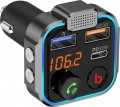AUX (Line-in)
Wired audio input, usually in the form of a standard 3.5mm mini-jack. The
line-in (Aux) input can usually be output from a normal headphone output on a mobile phone or other similar device. And in some models of FM transmitters for linear connection, even their own wire with a 3.5 mm plug can be provided, which eliminates the need to use third-party cables.
Bass Boost
Bass boost function for powerful and rich bass.
Bass Boost is implemented in the form of a single button, with which you can actually “turn the bass on and off”.
Card reader
A slot that allows you to install memory cards in the FM transmitter and play music from them. Most often, card readers are made for SD or microSD form factor cards; however, both varieties have several variations (SDHC, SDXC), so before using such a transmitter, it's ok to clarify which varieties the
card reader is compatible with.
Max. memory card / flash drive capacity
The maximum size of a memory card or USB-drive (flash drive) supported by the transmitter.
For more information about memory cards and flash drives, see "Cart Reader" and "USB Input", respectively. Here we note that a modern FM transmitter can support two types of media at once; in such cases, the volume limit is often relevant for both flash drives and memory cards, but this nuance does not hurt to further clarify the documentation. Anyway, this limitation is primarily due to the fact that a higher storage capacity requires a more powerful hardware; in addition, there are nuances associated with individual subspecies of memory cards. Anyway, it is impossible to exceed the maximum allowable volume — this can lead to malfunctions and even to hardware breakdowns.
Media support
File formats supported by the FM transmitter.
Almost all models support the MP3 format, which is the most common modern digital audio format. Some devices are also capable of working with WMA — this is also one of the main formats, but for a number of reasons it is used much less often. And even less common is compatibility with WAV — this format provides higher sound quality, but with FM broadcasting this advantage is lost, and the files themselves take up noticeably more space than MP3 and WMA.



